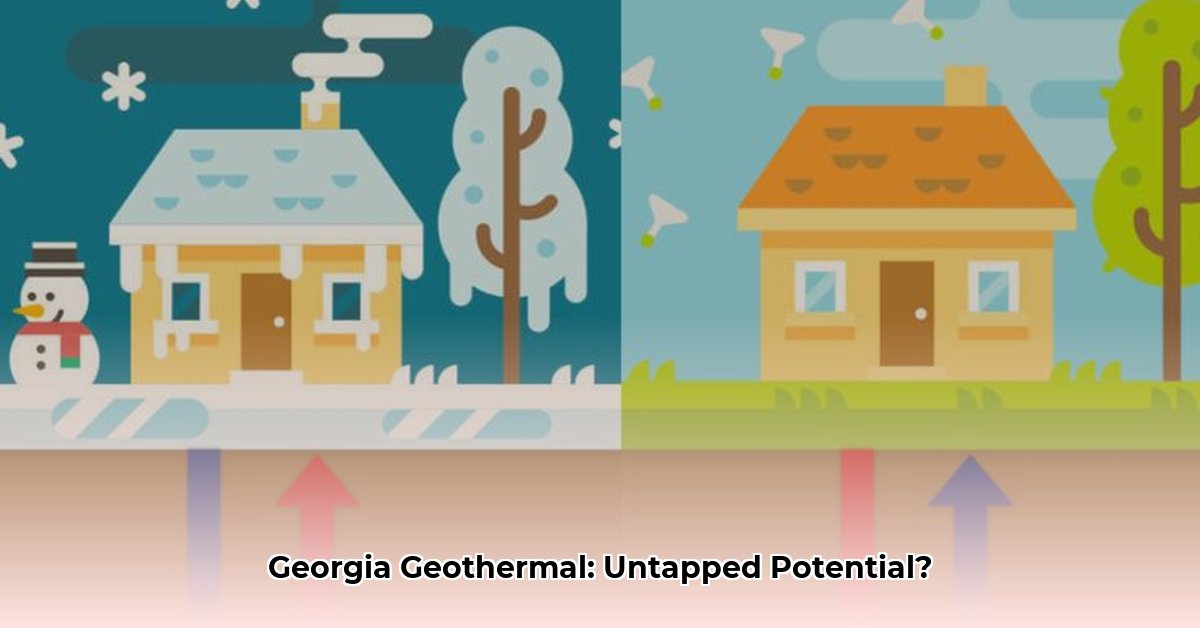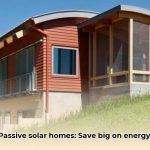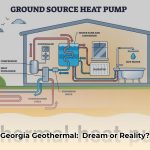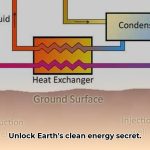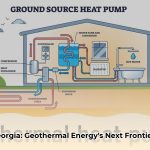Yes! Geothermal energy is a viable option in Georgia. While the state isn’t known for geysers, the consistent underground temperature offers an ideal environment for geothermal heat pumps (GHPs). This guide explores GHPs, covering how they work, their pros and cons, installation, maintenance, costs, incentives, and other geothermal applications in Georgia.
Geothermal Heat Pumps: Tapping Earth’s Energy
GHPs leverage the earth’s stable underground temperature. A few feet below the surface, the temperature remains relatively constant year-round. This makes the earth a natural thermal battery, storing heat in the winter and coolth in the summer.
How GHPs Work: A Step-by-Step Guide
- Winter Heating: Fluid circulates through a buried pipe network (the ground loop), absorbing the earth’s warmth. The slightly warmed fluid returns to a heat pump inside your home. This heat pump concentrates the heat and distributes it, keeping you warm.
- Summer Cooling: The process reverses. The fluid absorbs excess heat from your home and travels through the ground loop, dissipating the heat into the cooler earth. The cooled fluid returns to the heat pump, which circulates cool air throughout your house.
Georgia and GHPs: A Perfect Match?
Georgia’s moderate climate and stable underground conditions make it well-suited for GHPs. While underground temperatures vary slightly across the state, the consistency a few feet below the surface allows GHPs to operate efficiently, providing reliable heating and cooling.
Advantages of GHPs in Georgia
- Cost Savings: GHPs are highly energy-efficient, potentially reducing heating and cooling costs by 30-60%, and sometimes even up to 70%.
- Environmental Benefits: GHPs utilize renewable geothermal energy, reducing reliance on fossil fuels and minimizing your carbon footprint.
- Longevity: With proper maintenance, the indoor components of a GHP can last 25+ years, and the ground loop can last 50+ years, reducing the need for replacements.
Drawbacks of GHPs
- High Initial Cost: The upfront investment for a GHP is typically higher than for a traditional HVAC system. However, long-term energy savings and incentives can offset this.
- Land Requirements: GHPs require space for the ground loop. Horizontal loops need more land than vertical loops, which are suitable for properties with limited space.
GHP Installation and Maintenance
Finding a Qualified Installer
Research certified GHP installers in your area. Obtain multiple quotes and compare experience, warranties, and proposed system designs. Look for certifications from organizations like the International Ground Source Heat Pump Association (IGSHPA).
Installation Process
- Property Assessment: An installer assesses your property, including soil type, land availability, and heating/cooling needs to determine the best system design and ground loop configuration.
- Ground Loop Installation: The installer buries the ground loop horizontally or vertically, depending on the property and system design.
- Connection to Home: The ground loop is connected to the heat pump inside your home and integrated with existing ductwork.
- Testing and Commissioning: The installer tests the system to ensure efficient operation and performance.
Maintenance
GHPs are relatively low-maintenance but require regular checkups by a qualified technician. This includes annual inspections, filter changes, and occasional checks of system components.
Costs, Incentives, and Savings
Installation Costs
GHP installation costs vary based on factors such as property size, system size, ground loop configuration, and labor costs. Obtain detailed quotes from multiple installers for accurate pricing.
Energy Savings
GHPs can significantly reduce energy consumption, leading to substantial savings on utility bills over time. The exact savings depend on factors like energy usage, climate, and system efficiency.
Incentives
- Federal Tax Credits: Explore available federal tax credits for energy-efficient systems, including GHPs. Check the Database of State Incentives for Renewables & Efficiency (DSIRE) for current information.
- State and Local Incentives: Check with the Georgia Department of Natural Resources and your local utility company for potential state and local incentives or rebates.
Other Geothermal Applications in Georgia
- Direct Use Geothermal: This involves using geothermal water directly for heating. While opportunities are limited in Georgia, potential may exist in some areas.
- Enhanced Geothermal Systems (EGS): EGS taps into deeper, hotter resources to generate electricity. While still largely in the research and development phase, it holds promise for future power generation in Georgia.
Comparing HVAC Systems
| Feature | Geothermal | Traditional HVAC | Solar Thermal |
|---|---|---|---|
| Efficiency | Very High | Moderate | Moderate (sun-dependent) |
| Environmental Impact | Very Low | Moderate to High | Low |
| Operating Cost | Very Low | Moderate to High | Low |
| Upfront Cost | High | Low | Moderate |
| Lifespan | Very Long | Moderate | Moderate |
| Reliability | Very High | High | Moderate (weather-dependent) |
GHPs offer superior energy efficiency and environmental benefits compared to traditional HVAC. Unlike solar thermal, GHPs provide consistent performance regardless of weather.
Conclusion
Geothermal energy, specifically GHPs, provides a sustainable, efficient, and environmentally friendly heating and cooling solution for Georgia homeowners. While the initial cost is higher, the long-term savings, environmental benefits, and increased home value make GHPs a worthwhile investment.
Resources
- Georgia Department of Natural Resources
- U.S. Department of Energy
- International Ground Source Heat Pump Association (IGSHPA)
- Database of State Incentives for Renewables & Efficiency (DSIRE)
Disclaimer: This information is for educational purposes and is not professional advice. Consult qualified professionals for project-specific guidance.
- Water Wheel Electric Generator Provides Free Home Electricity - December 15, 2025
- Choosing the Right Portable Hydro Turbine for Your Needs - December 14, 2025
- Best Portable Hydro Generators for Off-Grid and Outdoor Power - December 13, 2025
